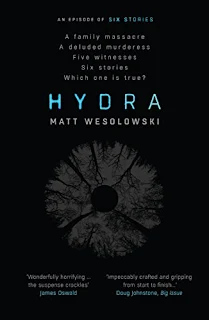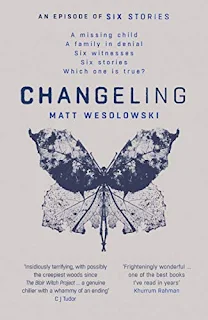In case you're interested, here are my other posts from 2021 so far: January, February, March
One by One by Freida McFadden (2020)
For some reason, I was back on my ‘Books Like And Then There Were None’ kick this month… with somewhat different results to last time. I’ve still not read The Ninth Guest (the book the precursor to And Then There Were None), but I did find two books on Prime Reading that looked promising. First up, I read One by One – not One by One by Ruth Ware, but a different One by One. Hmmm… One by One by Freida McFadden is about a group of friends – Claire (the narrator), Noah (her husband), Lindsay (her best friend), Warner (Lindsay’s new boyfriend), and Jack and Michelle (their old college friends). The group are heading off to a luxury spa, which is somewhat surprisingly set in the midst of a forbidding forest that may or may not be home to bears and coyotes. Of course, as soon as they get to the forest (with no mobile reception), the car breaks down and they’re forced to head out on foot. We’re already primed for the deaths to start, by both the title and the use of the near-ubiquitous chapter-in-italics-with-an-undisclosed-narrator technique. One by One is an alright read, but it’s a bit predictable and the characters aren’t the most nuanced. It also uses an… erm… familiar trope (from And Then There Were None and Saw) but in a way that makes it quite obvious what’s going on. All in all, this isn’t the worst Prime Reading book I’ve read, but it isn’t the best.
The House Party by Mary Grand (2020)
And onto the next one… The House Party sounds like it’s going to be classic And Then There Were None territory, doesn’t it? Well, sadly, it isn’t. The eponymous party is simply the backdrop to the first chapter – all of which takes place outside the party rather than actually in it. The party in question is a housewarming for Kathleen and Patrick’s fancy new house, and all their friends are having a great time. Kathleen isn’t, though, and she takes time out to talk to her mild-mannered friend Beth (who is the novel’s protagonist) about what’s bothering her. Of course, she doesn’t give quite enough detail – she just says that someone at the party has been threatening her, and that she’s worried they know her big secret – so when she turns up dead shortly afterwards, Beth doesn’t have a lot to go on. The party itself isn’t really an important plot point, but it serves to provide a list of suspects. I’ll admit that there was a lot here that didn’t work for me (e.g. the murderer is really obvious, and there’s a very odd eBay link embedded into the text for some reason), but I did like the main character. I enjoyed seeing Beth coming into her own as she insisted on pursuing the truth, despite all her friends telling her to let it drop. Other than that, this one didn’t really do it for me. Like One by One, there weren’t a lot of surprises with this one.
The Arrangement by Miranda Rijks (2020)
I really can’t explain what happened next. I have a towering to-read pile, and I only read One by One and The House Party because of my And Then There Were None thing. I don’t know why I went on to read The Arrangement, which certainly didn’t give any indication that it would be something along those lines. It’s a domestic thriller that touches on the world of sugar daddies/babies. But it isn’t The Arrangement by Robyn Harding (the ‘master of domestic suspense), which is set in the world of sugar daddies/babies. It’s a different The Arrangement. Between this and One by One, I feel like I’ve stumbled into the mockbuster section of Prime Reading (you know, like watching I Am Omega when you meant to watch I Am Legend, which wouldn’t be a bad thing – I Am Omega is great). I don’t have a huge amount to say about The Arrangement (the one I read), as it’s a fairly pedestrian thriller with an unremarkable conclusion. It’s another book marketed as having a ‘stunning twist’, when, in fact, it just has a standard reveal. Divorced mother-of-two Grace is devastated when her daughter Abi is murdered while on holiday in South Africa. The police believe it was a random attack by a drug addict, but when Grace discovers Abi was working as a sugar baby, she suspects there’s more to her daughter’s death. At least she has her oldest friends by her side to support her, eh? Not a strong recommendation.
Apartment 16 by Adam Nevill (2010)
I decided to switch from domestic thrillers to darker fare next, when I returned to my towering Abominable Books pile. The first one I chose from the pile was one of the ‘bonus’ (secondhand) books that come with the monthly subscription. Surprisingly enough, I hadn’t read Nevill’s Apartment 16 before. I’m very glad I have done now, though, as I really enjoyed it. The book’s protagonists are Apryl, a young American woman who has unexpectedly inherited a swanky London flat from an estranged great aunt, and Seth, a night porter who works in the building in which the flat is found. However, the book’s main character is really the apartment building itself. I completely fell in love with Barrington House! It’s an ostensibly upmarket block in one of the more expensive areas of London – a number of the flats belong to rich foreign businessmen and various upper class types. But what we actually see of Barrington House is an unsettling shadow of (probably) former glory. The flat Apryl inherits is gloomy and outdated, and it’s filled with the debris hoarded by her great aunt. Other flats that we ‘see’ reveal a similar story. The staff accommodation – what we see of it – is cramped, overheated and oppressive. And then there’s Apartment 16… this flat has been emptied for over 50 years, but the place has a strange effect on night porter Seth. I was definitely captivated by this setting, and the reveal of Apartment 16’s history was suitably chilling and unpleasant.
The Last House on Needless Street (2021)
I’m torn with this one. It was the featured book in the March Abominable Books box. It looks amazing, and it’s certainly had a lot of high praise. And that’s kind of the first problem… This is undoubtedly the most over-hyped book I’ve read in a long time. The hardback edition has FIVE pages of gushingly OTT blurbs from writers including Stephen King, Joanne Harris and Adam Nevill, describing the book as the most exciting thing they’ve ever read, better than Shirley Jackson, the best book since Gone Girl, etc. etc. No book could live up to that, and The Last House on Needless Street certainly doesn’t. Don’t get me wrong, it’s beautifully written, and it has several wonderfully-realized unreliable narrators (always a key to my heart). But the story itself is pretty mundane and predictable. Ted is a loner who lives in the eponymous house, sharing his life with a young girl he calls his daughter and his cat (who sometimes narrates). Dee is a troubled woman searching for her sister Lulu, who disappeared a decade earlier. The book sets us up for one story, before revealing that something else is going on. The author includes an earnest afterword and bibliography about that something else, stating that she wanted to write sensitively about a horror cliché. However, in order to do that, the book falls back on probably the most clichéd trope of the genre. The Last House on Needless Street is good, but it’s not Shirley Jackson good.





































